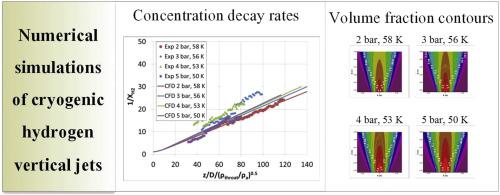International Journal of Hydrogen Energy ( IF 8.1 ) Pub Date : 2020-09-12 , DOI: 10.1016/j.ijhydene.2020.08.021 S.G. Giannissi , A.G. Venetsanos , E.S. Hecht

|
Comparison of Computational Fluid Dynamics (CFD) predictions with measurements is presented for cryo-compressed hydrogen vertical jets. The stagnation conditions of the experiments are characteristic of unintended leaks from pipe systems that connect cryogenic hydrogen storage tanks and could be encountered at a fuel cell refueling station. Jets with pressure up to 5 bar and temperatures just above the saturation liquid temperature were examined. Comparisons are made to the centerline mass fraction and temperature decay rates, the radial profiles of mass fraction and the contours of volume fraction. Two notional nozzle approaches are tested to model the under-expanded jet that was formed in the tests with pressures above 2 bar. In both approaches the mass and momentum balance from the throat to the notional nozzle are solved, while the temperature at the notional nozzle was assumed equal to the nozzle temperature in the first approach and was calculated by an energy balance in the second approach. The two approaches gave identical results. Satisfactory agreement with the measurements was found in terms of centerline mass fraction and temperature. However, for test with 3 and 4 bar release the concentration was overpredicted. Furthermore, a wider radial spread was observed in the predictions possibly revealing higher degree of diffusion using the k-ε turbulence model. An integral model for cryogenic jets was also developed and provided good results. Finally, a test simulation was performed with an ambient temperature jet and compared to the cold jet showing that warm jets decay faster than cold jets.
中文翻译:

低温氢垂直射流的数值预测
提出了对低温压缩氢垂直射流的计算流体动力学(CFD)预测与测量结果的比较。实验的停滞条件是连接低温氢存储罐的管道系统意外泄漏的特征,可能在燃料电池加油站遇到。检查了压力高达5巴且温度刚好高于饱和液体温度的喷嘴。比较中心线质量分数和温度衰减率,质量分数的径向轮廓和体积分数的轮廓。测试了两种概念性喷嘴方法,以模拟在压力大于2 bar的测试中形成的膨胀不足的射流。两种方法都解决了从喉部到假想喷嘴的质量和动量平衡,假设假想喷嘴处的温度等于第一种方法中的喷嘴温度,并通过第二种方法中的能量平衡来计算。两种方法给出了相同的结果。在中心线质量分数和温度方面发现与测量的令人满意的一致性。但是,对于3 bar和4 bar释放的测试,浓度被高估了。此外,在预测中观察到更宽的径向扩展,可能表明使用k-ε湍流模型具有更高的扩散程度。还开发了低温射流的积分模型,并提供了良好的结果。最后,使用环境温度射流进行了测试模拟,并将其与冷射流进行比较,结果表明,热射流的衰减速度比冷射流的衰减快。











































 京公网安备 11010802027423号
京公网安备 11010802027423号